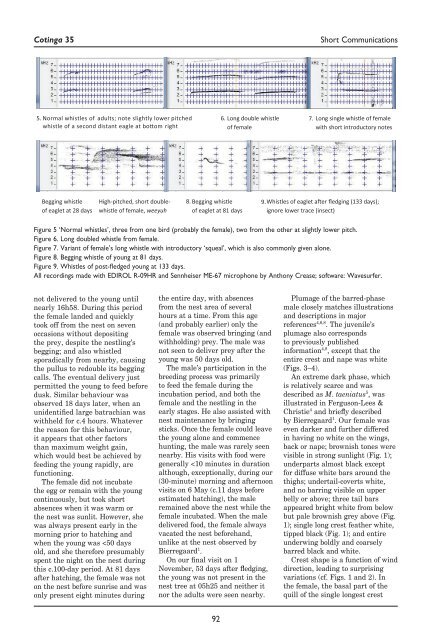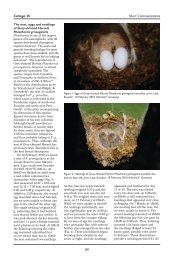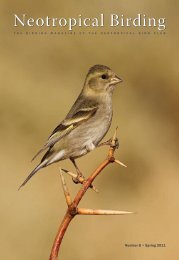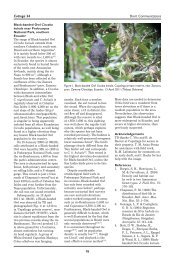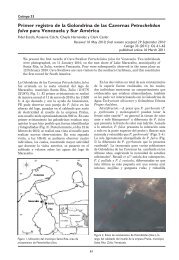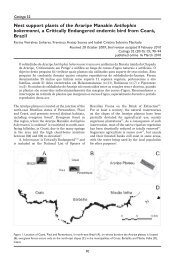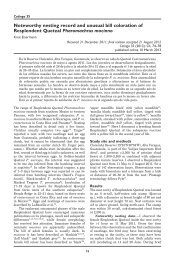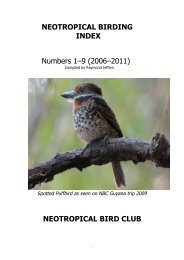Cot<strong>in</strong>ga 35Figure 3. Unfledged young <strong>Crested</strong> <strong>Eagle</strong> <strong>Morphnus</strong> <strong>guianensis</strong>, c.105 days <strong>of</strong> age, 30August 2011 (Anthony Crease)Figure 4. Juvenile <strong>Crested</strong> <strong>Eagle</strong> <strong>Morphnus</strong> <strong>guianensis</strong> <strong>in</strong> <strong>nest</strong> tree post-fledg<strong>in</strong>g, c.133days old, 27 September 2007 (Anthony Crease)Most trees around <strong>the</strong> <strong>nest</strong> havecrowns below c.24 m with a moreopen area and lower growth c.70m to <strong>the</strong> north-west, and an oldtreefall c.40 m to <strong>the</strong> south. The<strong>nest</strong> is higher than most adjacenttrees, particularly those downslope<strong>the</strong>reby provid<strong>in</strong>g a wide view over<strong>the</strong> canopy to <strong>the</strong> north, whichdirection was normally used by <strong>the</strong>eagles for take-<strong>of</strong>f. The <strong>nest</strong> wasc.1 m <strong>in</strong> diameter, 0.8 m deep, andcomprised sticks up to c.3 cm <strong>in</strong>diameter, with lianas grow<strong>in</strong>g on<strong>the</strong> sides, possibly orig<strong>in</strong><strong>at</strong><strong>in</strong>g fromleafy lianas brought by <strong>the</strong> eagles(Fig. 2). Such ‘adorn<strong>in</strong>g’ <strong>of</strong> <strong>the</strong> <strong>nest</strong>with greenery has been reportedpreviously 1 .We visited <strong>the</strong> <strong>nest</strong> on 22occasions between 1 April and 1November 2011, for a total <strong>of</strong> 70hours, <strong>in</strong>clud<strong>in</strong>g some day-longvisits. We were unable to preciselydeterm<strong>in</strong>e <strong>the</strong> d<strong>at</strong>es <strong>of</strong> lay<strong>in</strong>g andh<strong>at</strong>ch<strong>in</strong>g. However, we did observeShort Communic<strong>at</strong>ions<strong>the</strong> young eagle’s first flightsand could <strong>the</strong>refore estim<strong>at</strong>e <strong>the</strong>h<strong>at</strong>ch<strong>in</strong>g d<strong>at</strong>e as 17 May, basedon 114 days to fledg<strong>in</strong>g 10 . Bycompar<strong>in</strong>g our own observ<strong>at</strong>ionswith 11 developmental milestonesprovided by Whitacre et al. 10 ,we can confirm 17 May as a fairestim<strong>at</strong>e <strong>of</strong> h<strong>at</strong>ch<strong>in</strong>g d<strong>at</strong>e. Lay<strong>in</strong>gand commencement <strong>of</strong> brood<strong>in</strong>goccurred between 1 and 15 April,consistent with <strong>the</strong> <strong>in</strong>cub<strong>at</strong>ionperiod <strong>of</strong> 40–50 days assumed byBierregaard 1 .We first saw <strong>the</strong> young eagleon 30 June, <strong>at</strong> c.44 days <strong>of</strong> age (itwas not seen on days 10, 13, 21and 28). On 30 June <strong>the</strong> femalewas away from <strong>the</strong> <strong>nest</strong> for 80%<strong>of</strong> <strong>the</strong> day, <strong>in</strong>clud<strong>in</strong>g a period<strong>of</strong> 30 m<strong>in</strong>utes <strong>of</strong> light ra<strong>in</strong>fall.In lowland Gu<strong>at</strong>emala 10 , <strong>the</strong>female only left <strong>the</strong> young alone<strong>at</strong> 59 days. It is probable th<strong>at</strong>this difference reflects <strong>the</strong> coolerclim<strong>at</strong>e (and considerably higherelev<strong>at</strong>ion) <strong>of</strong> our site, reliev<strong>in</strong>g <strong>the</strong>female <strong>of</strong> <strong>the</strong> need to shade <strong>the</strong>young earlier <strong>in</strong> its development.Development <strong>of</strong> <strong>the</strong> young andadult behaviour was o<strong>the</strong>rwisesimilar to those <strong>in</strong> lowlandGu<strong>at</strong>emala, with two exceptions.Firstly, <strong>the</strong> young appeared lessexcitable (e.g., less jump<strong>in</strong>g dur<strong>in</strong>gw<strong>in</strong>g exercis<strong>in</strong>g and less reactionto over-fly<strong>in</strong>g vultures and o<strong>the</strong>rlarge birds) and secondly, andmore significantly, we observed<strong>the</strong> female withhold food from<strong>the</strong> young for many hours, dur<strong>in</strong>gconsecutive full-day visits 81and 99 days after estim<strong>at</strong>edh<strong>at</strong>ch<strong>in</strong>g, which behaviour has notpreviously been reported <strong>in</strong> <strong>the</strong>liter<strong>at</strong>ure.At 81 days, <strong>the</strong> female left <strong>the</strong><strong>nest</strong> area <strong>at</strong> 06h12, was seensoar<strong>in</strong>g overhead <strong>at</strong> 10h30 andreturned to <strong>the</strong> <strong>nest</strong> <strong>at</strong> 11h08,rema<strong>in</strong><strong>in</strong>g <strong>in</strong> <strong>the</strong> environswithout a break <strong>of</strong> more than 15m<strong>in</strong>utes until 14h13. Additionally,dur<strong>in</strong>g this period, <strong>the</strong> youngmade begg<strong>in</strong>g whistles almostconstantly, aga<strong>in</strong> imply<strong>in</strong>g <strong>the</strong>adult’s cont<strong>in</strong>uous presence. At13h16 <strong>the</strong> female was seen with aWoolly Mouse Opossum Micoureusdemerarae, presumably captureddur<strong>in</strong>g <strong>the</strong> period <strong>of</strong> absence priorto 11h08. However, <strong>the</strong> prey was91
Cot<strong>in</strong>ga 35Short Communic<strong>at</strong>ions5. Normal whistles <strong>of</strong> adults; note slightly lower pitched 6. Long double whistle7. Long s<strong>in</strong>gle whistle <strong>of</strong> femalewhistle <strong>of</strong> a second distant eagle <strong>at</strong> boom right<strong>of</strong> femalewith short <strong>in</strong>troductory notesBegg<strong>in</strong>g whistle<strong>of</strong> eaglet <strong>at</strong> 28 daysHigh-pitched, short doublewhistle<strong>of</strong> female, weeyuh8. Begg<strong>in</strong>g whistle 9. Whistles <strong>of</strong> eaglet aer fledg<strong>in</strong>g (133 days);<strong>of</strong> eaglet <strong>at</strong> 81 days ignore lower trace (<strong>in</strong>sect)Figure 5 ‘Normal whistles’, three from one bird (probably <strong>the</strong> female), two from <strong>the</strong> o<strong>the</strong>r <strong>at</strong> slightly lower pitch.Figure 6. Long doubled whistle from female.Figure 7. Variant <strong>of</strong> female’s long whistle with <strong>in</strong>troductory ‘squeal’, which is also commonly given alone.Figure 8. Begg<strong>in</strong>g whistle <strong>of</strong> young <strong>at</strong> 81 days.Figure 9. Whistles <strong>of</strong> post-fledged young <strong>at</strong> 133 days.All record<strong>in</strong>gs made with EDIROL R-09HR and Sennheiser ME-67 microphone by Anthony Crease; s<strong>of</strong>tware: Wavesurfer.not delivered to <strong>the</strong> young untilnearly 16h58. Dur<strong>in</strong>g this period<strong>the</strong> female landed and quicklytook <strong>of</strong>f from <strong>the</strong> <strong>nest</strong> on sevenoccasions without deposit<strong>in</strong>g<strong>the</strong> prey, despite <strong>the</strong> <strong>nest</strong>l<strong>in</strong>g’sbegg<strong>in</strong>g; and also whistledsporadically from nearby, caus<strong>in</strong>g<strong>the</strong> pullus to redouble its begg<strong>in</strong>gcalls. The eventual delivery justpermitted <strong>the</strong> young to feed beforedusk. Similar behaviour wasobserved 18 days l<strong>at</strong>er, when anunidentified large b<strong>at</strong>rachian waswithheld for c.4 hours. Wh<strong>at</strong>ever<strong>the</strong> reason for this behaviour,it appears th<strong>at</strong> o<strong>the</strong>r factorsthan maximum weight ga<strong>in</strong>,which would best be achieved byfeed<strong>in</strong>g <strong>the</strong> young rapidly, arefunction<strong>in</strong>g.The female did not <strong>in</strong>cub<strong>at</strong>e<strong>the</strong> egg or rema<strong>in</strong> with <strong>the</strong> youngcont<strong>in</strong>uously, but took shortabsences when it was warm or<strong>the</strong> <strong>nest</strong> was sunlit. However, shewas always present early <strong>in</strong> <strong>the</strong>morn<strong>in</strong>g prior to h<strong>at</strong>ch<strong>in</strong>g andwhen <strong>the</strong> young was


